Insight into Asymmetry in the Impact of Different Types of ENSO on the NAO
Abstract
1. Introduction
2. Materials and Methods
3. Results
3.1. Comparison of Different Types of ENSO and Related NAO
3.1.1. SSTA Patterns and Their Associated Tropic Atmospheric Responses
3.1.2. Unsteady Relationship of the ENSO with NAO
3.1.3. Possible Mechanisms for the Impact of WSGEN and SGLN on NAO
3.1.4. The Causes for the Abruption of ENSO and NAO Relations
4. Discussion
5. Conclusions
Author Contributions
Funding
Data Availability Statement
Conflicts of Interest
References
- Hurrell, J.W. Decadal Trends in the North Atlantic Oscillation: Regional Temperatures and Precipitation. Science 1995, 269, 676–679. [Google Scholar] [CrossRef] [PubMed]
- Thompson, D.W.; Wallace, J.M. The Arctic Oscillation signature in the wintertime geopotential height and temperature fields. Geophys. Res. Lett. 1998, 25, 1297–1300. [Google Scholar] [CrossRef]
- Li, J.; Wang, J. A new North Atlantic Oscillation index and its variability. Adv. Atmos. Sci. 2003, 20, 661–676. [Google Scholar]
- Deser, C.; Hurrell, J.W.; Phillips, A.S. The role of the North Atlantic Oscillation in European climate projections. Clim. Dyn. 2017, 49, 3141–3157. [Google Scholar] [CrossRef]
- Branstator, G.; Selten, F. “Modes of Variability” and Climate Change. J. Clim. 2009, 22, 2639–2658. [Google Scholar] [CrossRef]
- Hurrell, J.W.; Deser, C. North Atlantic climate variability: The role of the north atlantic oscillation. J. Mar. Syst. 2009, 78, 28–41. [Google Scholar] [CrossRef]
- Butler, A.H.; Polvani, L.M.; Deser, C. Separating the stratospheric and tropospheric pathways of El Niño–Southern Oscillation teleconnections. Environ. Res. Lett. 2014, 9, 024014. [Google Scholar] [CrossRef]
- Scaife, A.A.; Arribas, A.; Blockley, E.; Brookshaw, A.; Clark, R.T.; Dunstone, N.; Eade, R.; Fereday, D.; Folland, C.K.; Gordon, M.; et al. Skillful long-range prediction of European and North American winters. Geophys. Res. Lett. 2014, 41, 2514–2519. [Google Scholar] [CrossRef]
- Kidston, J.; Scaife, A.A.; Hardiman, S.C.; Mitchell, D.M.; Butchart, N.; Baldwin, M.P.; Gray, L.J. Stratospheric influence on tropospheric jet streams, storm tracks and surface weather. Nat. Geosci. 2015, 8, 433–440. [Google Scholar] [CrossRef]
- Hoerling, M.P.; Hurrell, J.W.; Xu, T.; Bates, G.T.; Phillips, A.S. Twentieth century north atlantic climate change. Part II. Understanding the effect of indian ocean warming. Clim. Dyn. 2004, 23, 391–405. [Google Scholar] [CrossRef]
- Bracco, A.; Kucharski, F.; Kallummal, R.; Molteni, F. Internal variability, external forcing and climate trends in multi-decadal AGCM ensembles. Clim. Dyn. 2004, 23, 659–678. [Google Scholar] [CrossRef]
- Li, Y.; Lau, N.C. Impact of ENSO in the atmospheric variability over the North Atlantic in late winter—Role of transient eddies. J. Clim. 2012, 25, 320–342. [Google Scholar] [CrossRef]
- Wyrtki, K. El Niño—The Dynamic Response of the Equatorial Pacific Oceanto Atmospheric Forcing. J. Phys. Oceanogr. 1975, 5, 572–584. [Google Scholar] [CrossRef]
- Qadimi, M.; Alizadeh, O.; Irannejad, P. Impacts of the El Niño-Southern Oscillation on the strength and duration of the Indian summer monsoon. Meteorol. Atmos. Phys. 2021, 133, 553–564. [Google Scholar] [CrossRef]
- Held, I.M.; Lyons, S.W.; Nigam, S. Transients and the extratropical response to El Niño. J. Atmos. Sci. 1989, 46, 163–174. [Google Scholar] [CrossRef]
- Alizadeh-Choobari, O.; Adibi, P.; Irannejad, P. Impact of the El Niño–Southern Oscillation on the climate of Iran using ERA-Interim data. Clim. Dyn. 2018, 51, 2897–2911. [Google Scholar] [CrossRef]
- Wang, B.; Wu, R.G.; Fu, X.H. Pacific–East Asia teleconnection: How does ENSO affect East Asian climate? J. Clim. 2000, 13, 1517–1536. [Google Scholar] [CrossRef]
- Ropelewski, C.F.; Halpert, M.S. Global and regional scale precipitation patterns associated with the El Niño/Southern Oscillation. Mon. Weather Rev. 1987, 115, 1606–1626. [Google Scholar] [CrossRef]
- Trenberth, K.E.; Caron, J.M. The Southern Oscillation revisited: Sea level pressure, surface temperatures, and precipitation. J. Clim. 2000, 13, 4358–4365. [Google Scholar] [CrossRef]
- Merkel, U.; Latif, M. A high-resolution AGCM study of the El Niño impact on the North Atlantic/European sector. Geophys. Res. Lett. 2002, 29, 1291. [Google Scholar] [CrossRef]
- Ineson, S.; Scaife, A.A. The role of the stratosphere in the European climate response to El Niño. Nat. Geosci. 2009, 2, 32–36. [Google Scholar] [CrossRef]
- Jiménez-Esteve, B.; Domeisen, D.I.V. The Tropospheric Pathway of the ENSO–North Atlantic Teleconnection. J. Clim. 2018, 31, 4563–4584. [Google Scholar] [CrossRef]
- Brönnimann, S. Impact of El Niño–Southern Oscillation on European climate. Rev. Geophys. 2007, 45, RG3003. [Google Scholar] [CrossRef]
- Zhang, W.; Wang, L.; Xiang, B.Q.; Qi, L.; He, J. Impacts of two types of La Nina on the NAO during boreal winter. Clim. Dyn. 2015, 44, 1351–1366. [Google Scholar] [CrossRef]
- Zhang, W.; Wang, Z.; Stuecker, M.F.; Turner, A.G.; Jin, A.G.; Geng, X. Impact of ENSO longitudinal position on teleconnections to the NAO. Clim. Dyn. 2019, 2, 257–274. [Google Scholar] [CrossRef]
- Zhang, P.; Wang, B.; Wu, Z. Weak El Niño and winter climate in the mid-high latitude Eurasia. J. Clim. 2019, 32, 402–421. [Google Scholar] [CrossRef]
- Zhang, P.; Wu, Z.; Li, J. Reexamining the relationship of La Niña and the east Asian winter monsoon. Clim. Dyn. 2019, 53, 779–791. [Google Scholar] [CrossRef]
- Zhang, P.; Wu, Z. Reexamining the connection of El Niño and North American winter climate. Int. J. Climatol. 2021, 41, 6133–6144. [Google Scholar] [CrossRef]
- Polvani, L.M.; Sun, L.; Butler, A.H.; Richter, J.H.; Deser, C. Distinguishing stratospheric sudden warmings from ENSO as key drivers of wintertime climate variability over the North Atlantic and Eurasia. J. Clim. 2017, 30, 1959–1969. [Google Scholar] [CrossRef]
- Wu, Z.; Zhang, P. Interdecadal variability of the mega-ENSO–NAO synchronization in winter. Clim. Dyn. 2015, 45, 1117–1128. [Google Scholar] [CrossRef]
- Capotondi, A.; Wittenberg, A.T.; Newman, M.; Di Lorenzo, E.; Yu, J.Y.; Braconnot, P.; Cole, J.; Dewitte, B.; Giese, B.; Guilyardi, E.; et al. Understanding ENSO diversity. Bull. Am. Meteorol. Soc. 2015, 96, 921–938. [Google Scholar] [CrossRef]
- McPhaden, M.J. Genesis and evolution of the 1997–1998 El Niño. Science 1999, 283, 950–954. [Google Scholar] [CrossRef] [PubMed]
- Jacox, M.G.; Hazen, E.L.; Zaba, K.D.; Rudnick, D.L.; Edwards, C.A.; Moore, A.M.; Bograd, S.J. Impacts of the 2015–2016 El Niño on the California current system: Early assessment and comparison to past events. Geophys. Res. Lett. 2016, 430, 7072–7080. [Google Scholar] [CrossRef]
- Toniazzo, T.; Scaife, A.A. The influence of ENSO on winter North Atlantic climate. Geophys. Res. Lett. 2006, 33, L24704. [Google Scholar] [CrossRef]
- Xue, F.; Liu, C. The influence of moderate ENSO on summer rainfall in eastern China and its comparison with strong ENSO. Chin. Sci. Bull. 2008, 53, 791–800. [Google Scholar] [CrossRef]
- Alizadeh-Choobari, O.; Najafi, M.S. Climate variability in Iran in response to the diversity of the El Niño-Southern Oscillation. Int. J. Climatol. 2018, 38, 4239–4250. [Google Scholar] [CrossRef]
- Kao, H.; Yu, J. Contrasting Eastern-Pacific and Central-Pacific Types of ENSO. J. Clim. 2009, 22, 615–632. [Google Scholar] [CrossRef]
- Alizadeh-Choobari, O. Contrasting global teleconnection features of the eastern Pacific and central Pacific El Niño events. Dyn. Atmos. Ocean 2017, 80, 139–154. [Google Scholar] [CrossRef]
- Feng, J.; Li, J.P.; Zheng, F.; Xie, F.; Sun, C. Contrasting impacts of developing phases of two types of El Niño on southern China rainfall. J. Meteorol. Soc. Jpn. 2016, 94, 359–370. [Google Scholar] [CrossRef]
- Wang, B.; Luo, X.; Yang, Y.M.; Sun, W.; Cane, M.A.; Cai, W.; Yeh, S.W.; Liu, J. Historical change of El Niño properties sheds light on future changes of extreme El Niño. Proc. Natl. Acad. Sci. USA 2019, 116, 22512–22517. [Google Scholar] [CrossRef]
- Bjerknes, J. Atmospheric teleconnections from the equatorial Pacific. Mon. Weather Rev. 1969, 97, 163–172. [Google Scholar] [CrossRef]
- Hoell, A.; Funk, C. The ENSO-related West Pacific Sea surface temperature gradient. J. Clim. 2013, 26, 9545–9562. [Google Scholar] [CrossRef]
- Liebmann, B.; Hoerling, M.P.; Funk, C.; Bladé, I.; Dole, R.M.; Allured, D.; Quan, X.; Pegion, P.; Eischeid, J.K. Understanding recent eastern horn of Africa rainfall variability and change. J. Clim. 2014, 27, 8630–8645. [Google Scholar] [CrossRef]
- Zinke, J.; Hoell, A.; Lough, J.M.; Feng, M.; Kuret, A.J.; Clarke, H.; Ricca, V.; Rankenburg, K.; McCulloch, M.T. Coral record of Southeast Indian Ocean marine heatwaves with intensified Western Pacific temperature gradient. Nat. Commun. 2015, 6, 8562. [Google Scholar] [CrossRef] [PubMed]
- Zhang, L.; Wu, Z.; Zhou, Y. Different impacts of typical and atypical ENSO on the Indian summer rainfall: ENSO developing phase. Atmos. Ocean 2016, 54, 440–456. [Google Scholar] [CrossRef]
- Meinen, C.S.; McPhaden, M.J. Observations of Warm Water Volume Changes in the Equatorial Pacific and Their Relationship to El Niño and La Niña. J. Clim. 2000, 13, 3551–3559. [Google Scholar] [CrossRef]
- Jin, F.-F.; An, S.; Timmermann, A.; Zhao, J. Strong El Niño Events and Nonlinear Dynamical Heating. Geophys. Res. Lett. 2003, 30, 1120. [Google Scholar] [CrossRef]
- An, S.-I.; Jin, F.-F. Why El Niño is Stronger than La Niña. J. Clim. 2004, 17, 2399–2412. [Google Scholar] [CrossRef]
- Larkin, N.K.; Harrison, D.E. ENSO warm (El Niño) and cold (La Niña) event life cycles: Ocean surface anomaly patterns, their symmetries, asymmetries, and implications. J. Clim. 2002, 15, 1118–1140. [Google Scholar] [CrossRef]
- Okumura, Y.M.; Deser, C. Asymmetry in the duration of El Niño and La Niña. J. Clim. 2010, 23, 5826–5843. [Google Scholar] [CrossRef]
- Chen, M.; Li, T. ENSO evolution asymmetry: EP versus CP El Niño. Clim. Dyn. 2021, 56, 3569–3579. [Google Scholar] [CrossRef]
- Zhang, R.; Li, T.-R.; Wen, M.; Liu, L.-K. Role of intraseasonal oscillation in asymmetric impacts of El Niño and La Niña on the rainfall over southern China in boreal winter. Clim. Dyn. 2015, 45, 559–567. [Google Scholar] [CrossRef]
- Song, X.; Zhang, R.; Rong, X. Influence of intraseasonal oscillation on the asymmetric decays of El Niño and La Niña. Adv. Atmos. Sci. 2019, 36, 779–792. [Google Scholar] [CrossRef]
- Huang, B.; Thorne, P.W.; Banzon, V.F.; Boyer, T.; Chepurin, G.; Lawrimore, J.H.; Menne, M.J.; Smith, T.M.; Vose, R.S.; Zhang, H.M. Extended reconstructed sea surface temperature, version 5 (ERSSTv5): Upgrades, validations, and intercomparisons. J. Clim. 2017, 30, 8179–8205. [Google Scholar] [CrossRef]
- Rayner, N.A.; Parker, D.E.; Horton, E.B.; Folland, C.K.; Alexander, L.V.; Rowell, D.P.; Kent, E.C.; Kaplan, A. Global analyses of sea surface temperature, sea ice, and night marine air temperatures since the late nineteenth century. J. Geophys. Res. 2003, 108, 4407. [Google Scholar] [CrossRef]
- Uppala, S.M.; Kållberg, P.W.; Simmons, A.J.; Andrae, U.; Bechtold VD, C.; Fiorino, M.; Gibson, J.K.; Haseler, J.; Hernandez, A.; Kelly, G.A.; et al. The ERA-40 re-analysis. Q. J. R. Meteorol. Soc. 2005, 131, 2961–3012. [Google Scholar] [CrossRef]
- Dee, D.P.; Uppala, S.M.; Simmons, A.J.; Berrisford, P.; Poli, P.; Kobayashi, S.; Andrae, U.; Balmaseda, M.A.; Balsamo, G.; Bauer, D.P.; et al. The ERA-Interim reanalysis: Configuration and performance of the data assimilation system. Q. J. R. Meteorol. Soc. 2011, 137, 553–597. [Google Scholar] [CrossRef]
- Chen, M.; Xie, P.; Janowiak, J.; Arkin, P.A. Global land precipitation: A 50-yr analysis based on gauge observations. J. Hydrometeorol. 2002, 3, 249–266. [Google Scholar] [CrossRef]
- Wang, B.; Liu, J.; Kim, H.J.; Webster, P.J.; Yim, S.Y.; Xiang, B.Q. Northern Hemisphere summer monsoon intensified by mega-El Niño/southern oscillation and Atlantic multidecadal oscillation. Proc. Natl. Acad. Sci. USA 2013, 110, 5347–5352. [Google Scholar] [CrossRef]
- Roeckner, E.; Bäuml, G.; Bonaventura, L.; Brokopf, R.; Esch, M.; Giorgetta, M.; Hagemann, S.; Kirchner, I.; Kornblueh, L.; Manzini, E.; et al. The atmospheric general circulation model ECHAM5. Part I: Model description. Max Planck Inst. Rep. 2003, 349, 140. [Google Scholar]
- Ashok, K.; Behera, S.; Rao, A.S.; Weng, H.Y.; Yamagata, T. El Niño Modoki and its possible teleconnection. J. Geophys. Res. 2007, 112, C11007. [Google Scholar] [CrossRef]
- Graf, H.-F.; Zanchettin, D. Central Pacific El Niño, the ‘subtropical bridge,’ and Eurasian climate. J. Geophys. Res. 2012, 117, D01102. [Google Scholar] [CrossRef]
- Saji, N.H.; Yamagata, T. Structure of SST and surface wind variability during Indian Ocean dipole mode events: COADS observations. J. Clim. 2003, 16, 2735–2751. [Google Scholar] [CrossRef]
- Luo, J.-J.; Zhang, R.; Behera, S.K.; Masumoto, Y.; Jin, F.-F.; Lukas, R.; Yamagata, T. Interaction between El Niño and extreme Indian Ocean dipole. J. Clim. 2010, 23, 726–742. [Google Scholar] [CrossRef]
- Cai, W.; van Rensch, P.; Cowan, T.; Hendon, H.H. An asymmetry in the IOD and ENSO teleconnection pathway and its impact on Australian climate. J. Clim. 2012, 25, 6318–6329. [Google Scholar] [CrossRef]
- Ha, K.J.; Chu, J.E.; Lee, J.Y.; Yun, K.S. Interbasin coupling between the tropical Indian and Pacific Ocean on interannual timescale: Observation and CMIP5 reproduction. Clim. Dyn. 2017, 48, 459–475. [Google Scholar] [CrossRef]
- Bader, J.; Latif, M. North Atlantic Oscillation response to anomalous Indian Ocean SST in a coupled GCM. J. Clim. 2005, 18, 5382–5389. [Google Scholar] [CrossRef]
- Lin, H.; Brunet, G.; Derome, J. An observed connection between the North Atlantic Oscillation and the Madden-Julian Oscillation. J. Clim. 2009, 22, 364–380. [Google Scholar] [CrossRef]
- Bader, J.; Latif, M. The impact of decadal-scale Indian Ocean sea surface temperature anomalies on Sahelian rainfall and the North Atlantic Oscillation. Geophys. Res. Lett. 2003, 30, 2169. [Google Scholar] [CrossRef]
- Hurrell, J.W.; Hoerling, M.P.; Phillips, A.; Xu, T. Twentieth century North Atlantic climate change. Part I: Assessing determinism. Clim. Dyn. 2004, 23, 371–389. [Google Scholar] [CrossRef]
- Graham, N.E.; Barnett, T.P. Sea surface temperature, surface wind divergence, and convection over tropical oceans. Science 1987, 238, 657–659. [Google Scholar] [CrossRef] [PubMed]
- Lau, K.-M.; Wu, H.T.; Bony, S. The Role of Large-Scale Atmospheric Circulation in the Relationship between Tropical Convection and Sea Surface Temperature. J. Clim. 1997, 10, 381–392. [Google Scholar] [CrossRef]
- Domeisen, D.I.; Garfinkel, C.I.; Butler, A.H. The teleconnection of El Niño Southern Oscillation to the stratosphere. Rev. Geophys. 2019, 57, 5–47. [Google Scholar] [CrossRef]
- Du, Y.; Xie, S.-P.; Hu, K.; Huang, G. Role of air–sea interaction in the long persistence of El Niño–induced North Indian Ocean warming. J. Clim. 2009, 22, 2023–2038. [Google Scholar] [CrossRef]
- Xie, S.-P. The Shape of Continents, Air-Sea Interaction, and the Rising Branch of the Hadley Circulation. In The Hadley Circulation: Past, Present and Future; Diaz, H., Bradley, R.S., Eds.; Kluwer Academic: Amsterdam, The Netherlands, 2004; pp. 121–152. [Google Scholar]
- Vimont, D.J.; Alexander, M.A.; Newman, M. Optimal growth of Central and East Pacific ENSO events. Geophys. Res. Lett. 2014, 41, 4027–4034. [Google Scholar] [CrossRef]
- Yu, J.-Y.; Kao, H.Y.; Lee, T. Subtropics-Related Interannual Sea Surface Temperature Variability in the Equatorial Central Pacific. J. Clim. 2010, 23, 2869–2884. [Google Scholar] [CrossRef]
- Yu, J.-Y.; Paek, H. Precursors of ENSO beyond the tropical Pacific. US CLIVAR Var. 2015, 13, 15–20. [Google Scholar]
- Alizadeh, O. Amplitude, duration, variability, and seasonal frequency analysis of the El Niño-Southern Oscillation. Clim. Chang. 2022, 174, 20. [Google Scholar] [CrossRef]
- Wu, Z.; Lin, H. Interdecadal variability of the ENSO-North Atlantic Oscillation connection in boreal summer. Q. J. R. Meteorol. Soc. 2012, 138, 1668–1675. [Google Scholar] [CrossRef]
- Seager, R.; Kushnir, Y.; Nakamura, J.; Ting, M.; Naik, N. Northern Hemisphere winter snow anomalies: ENSO, NAO and the winter of 2009/10. Geophys. Res. Lett. 2010, 37, L14703. [Google Scholar] [CrossRef]
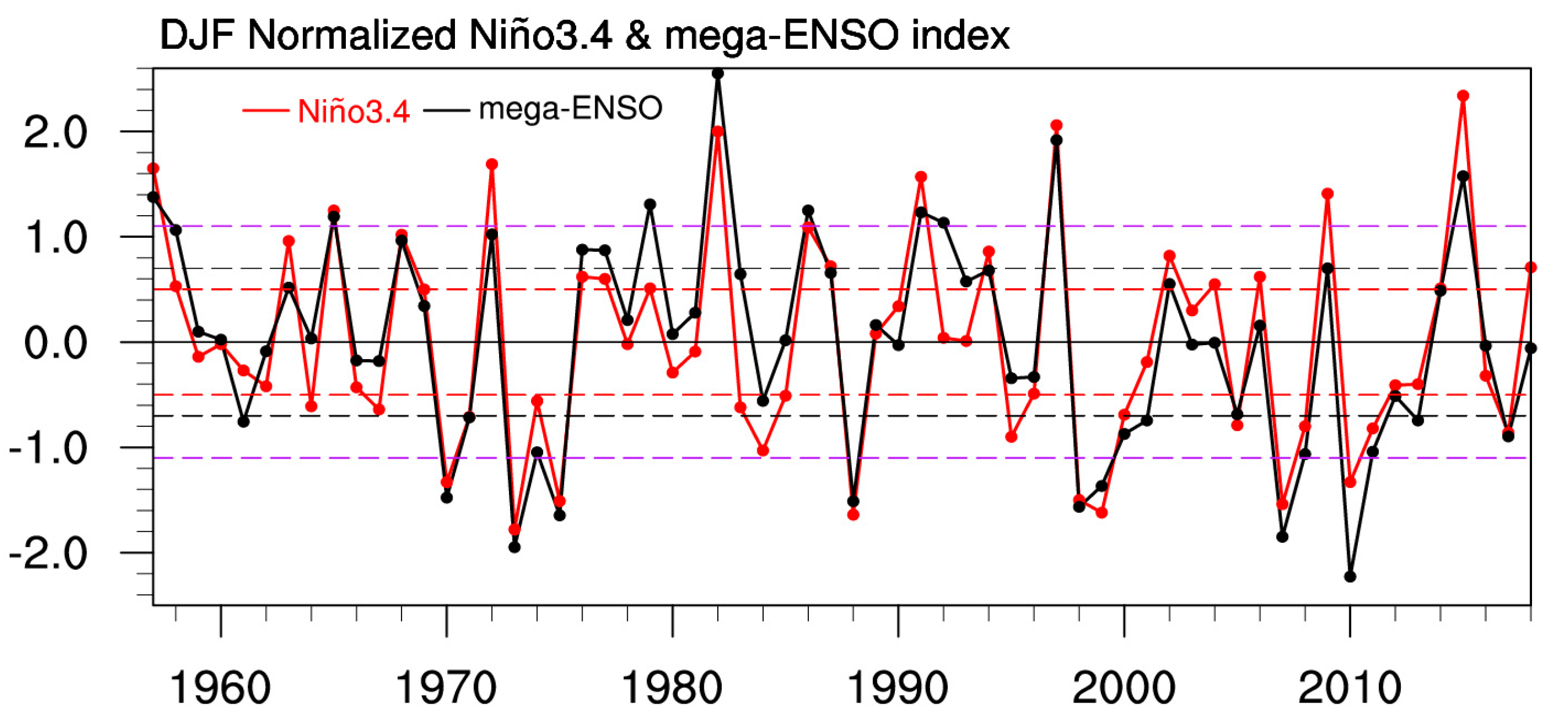

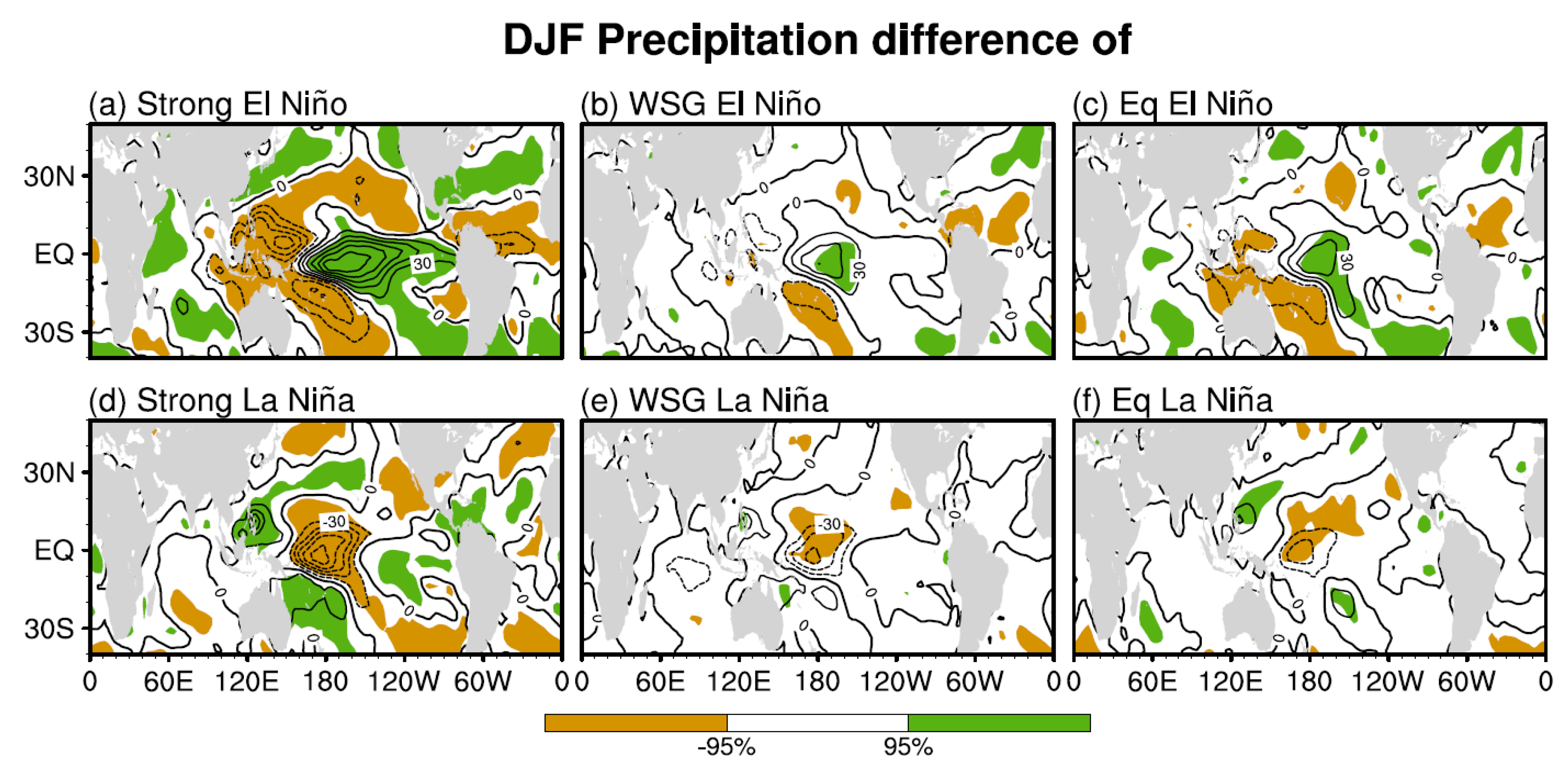
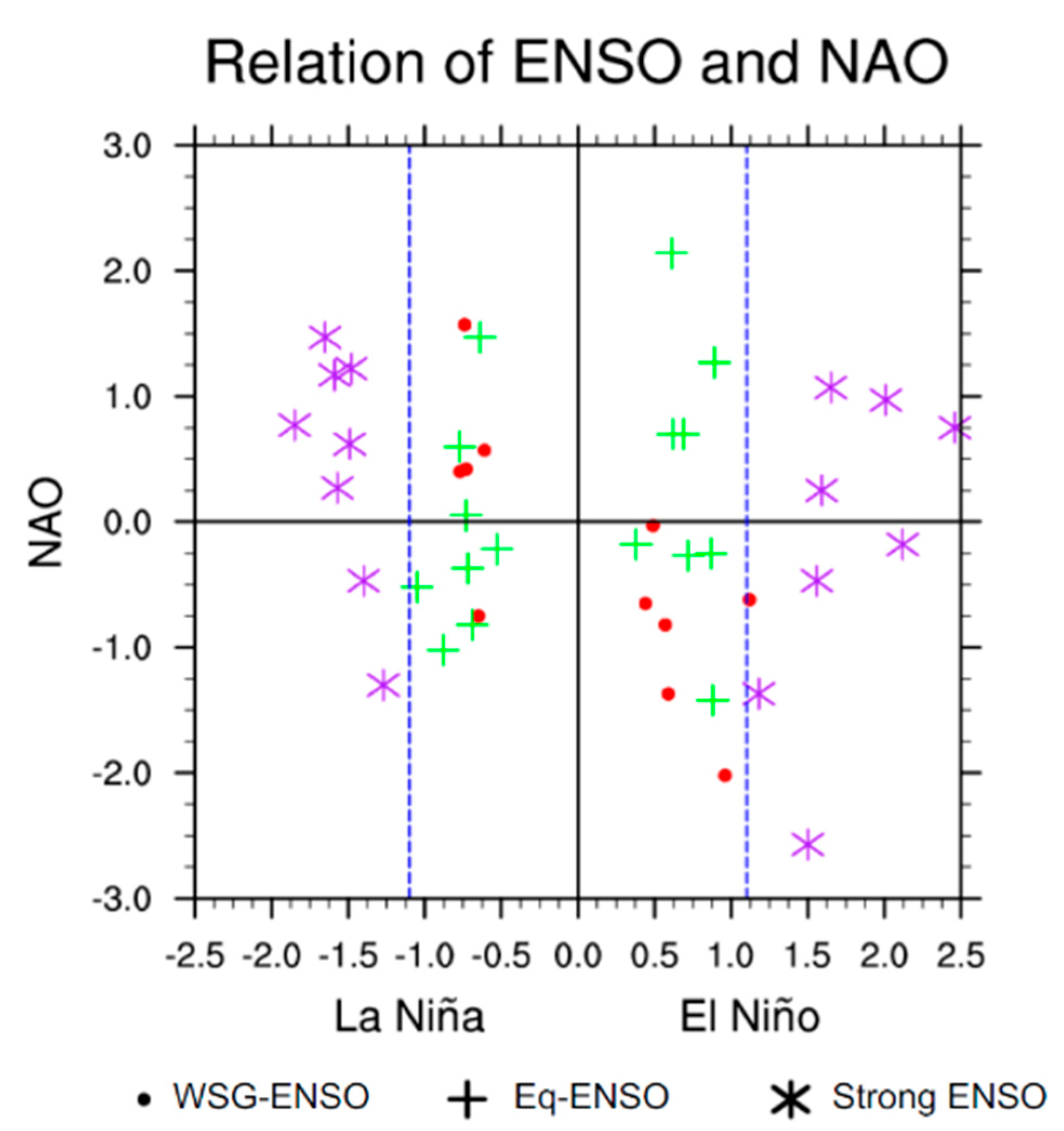
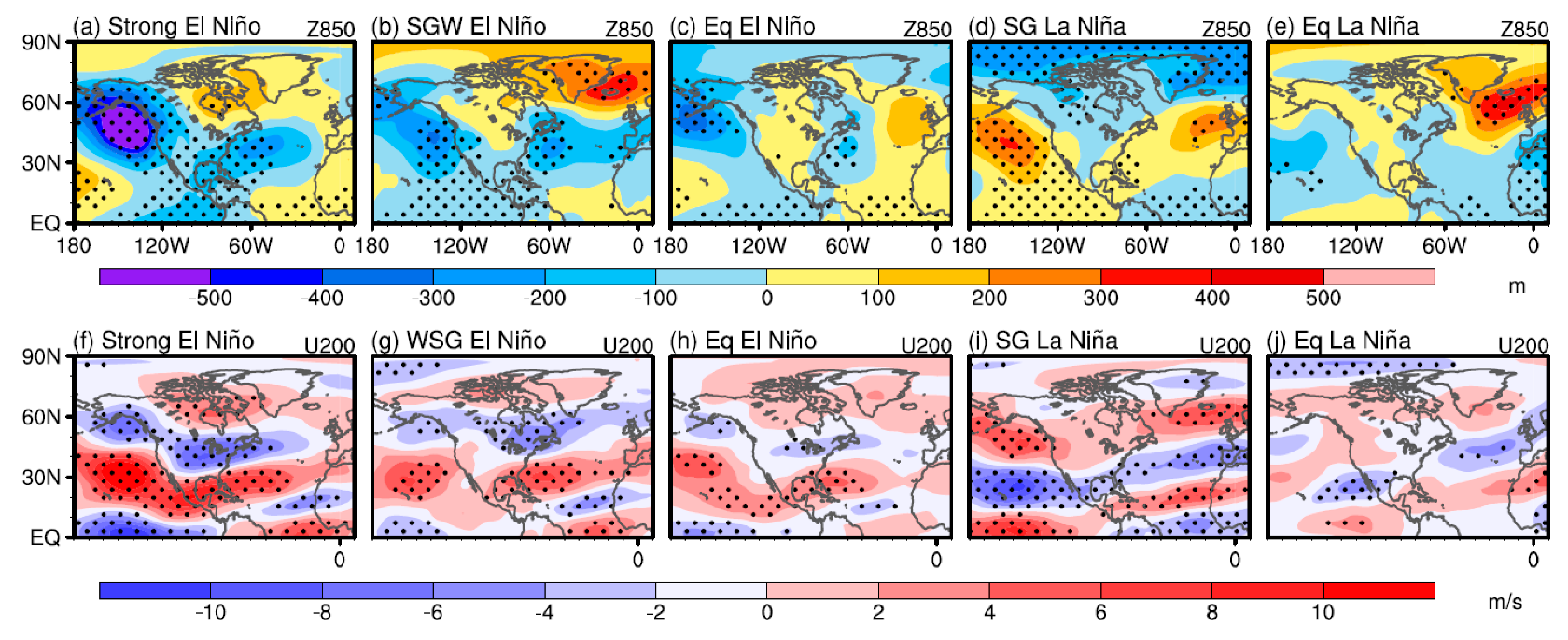


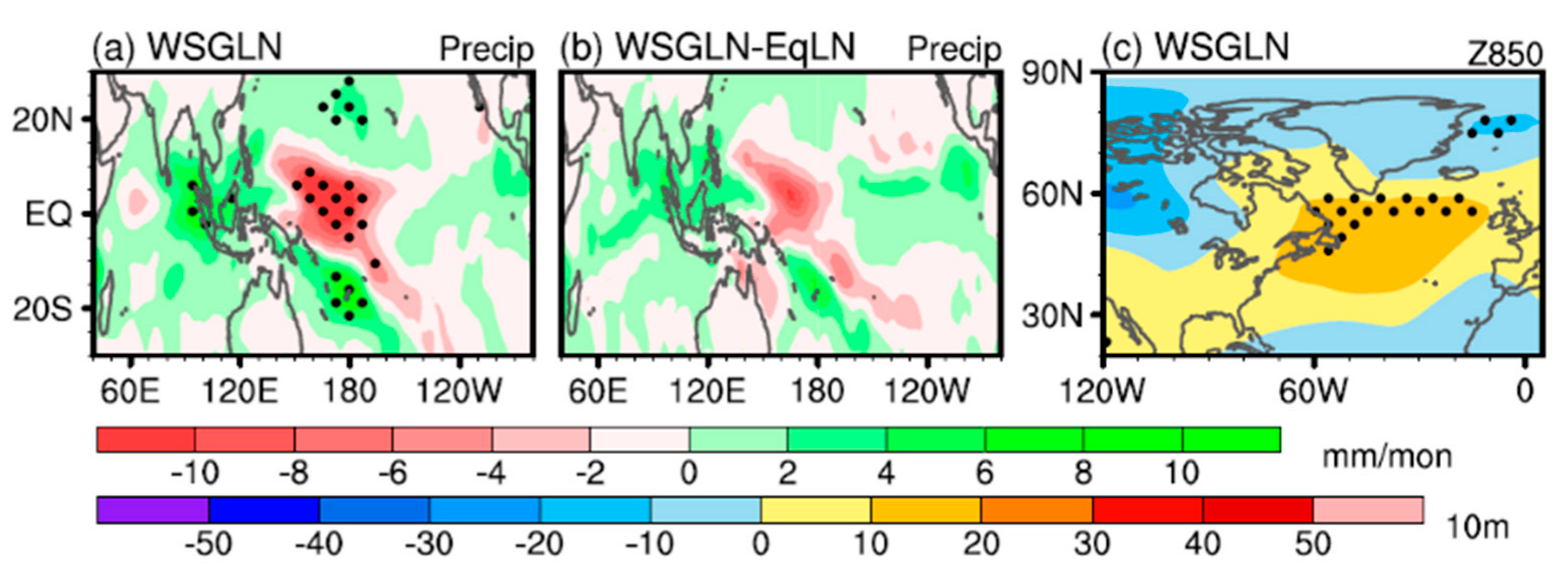
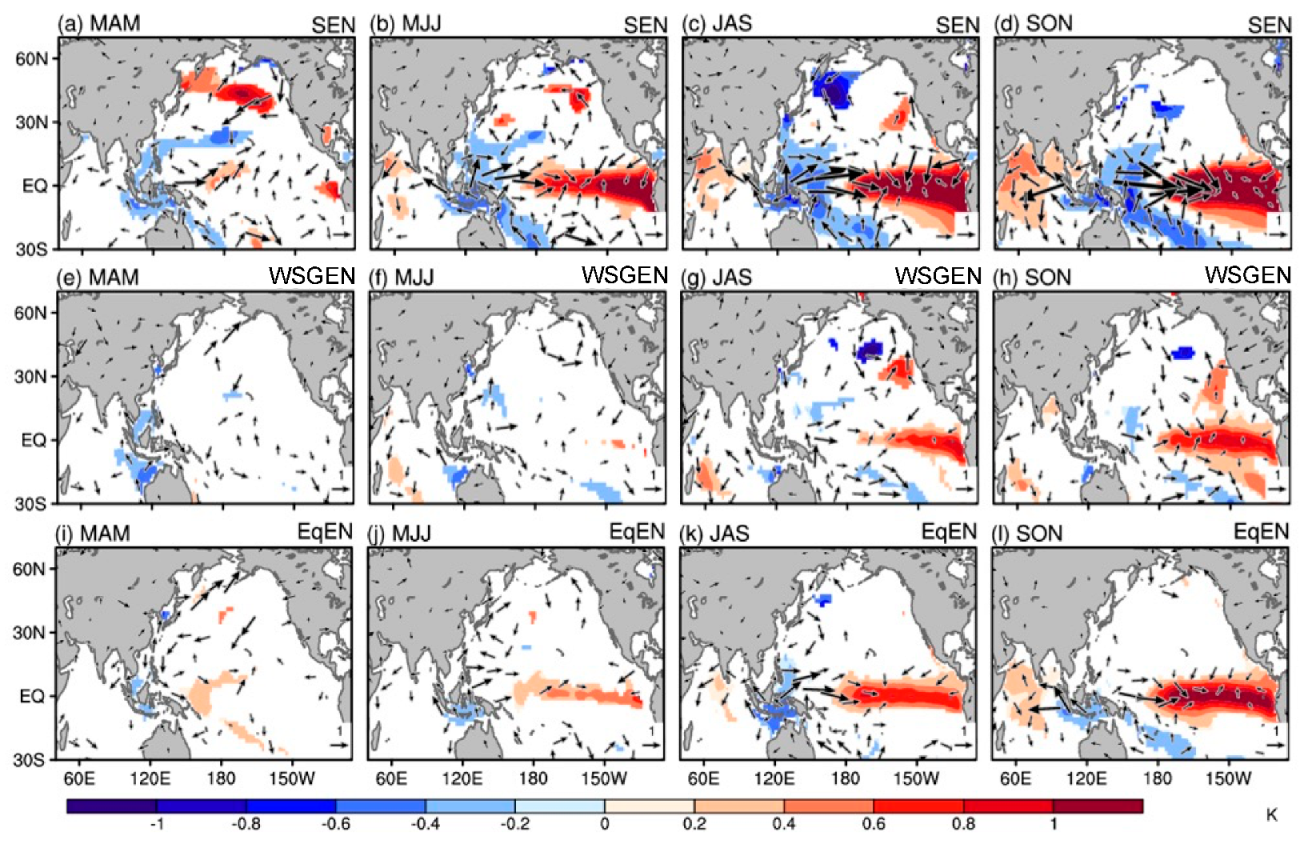
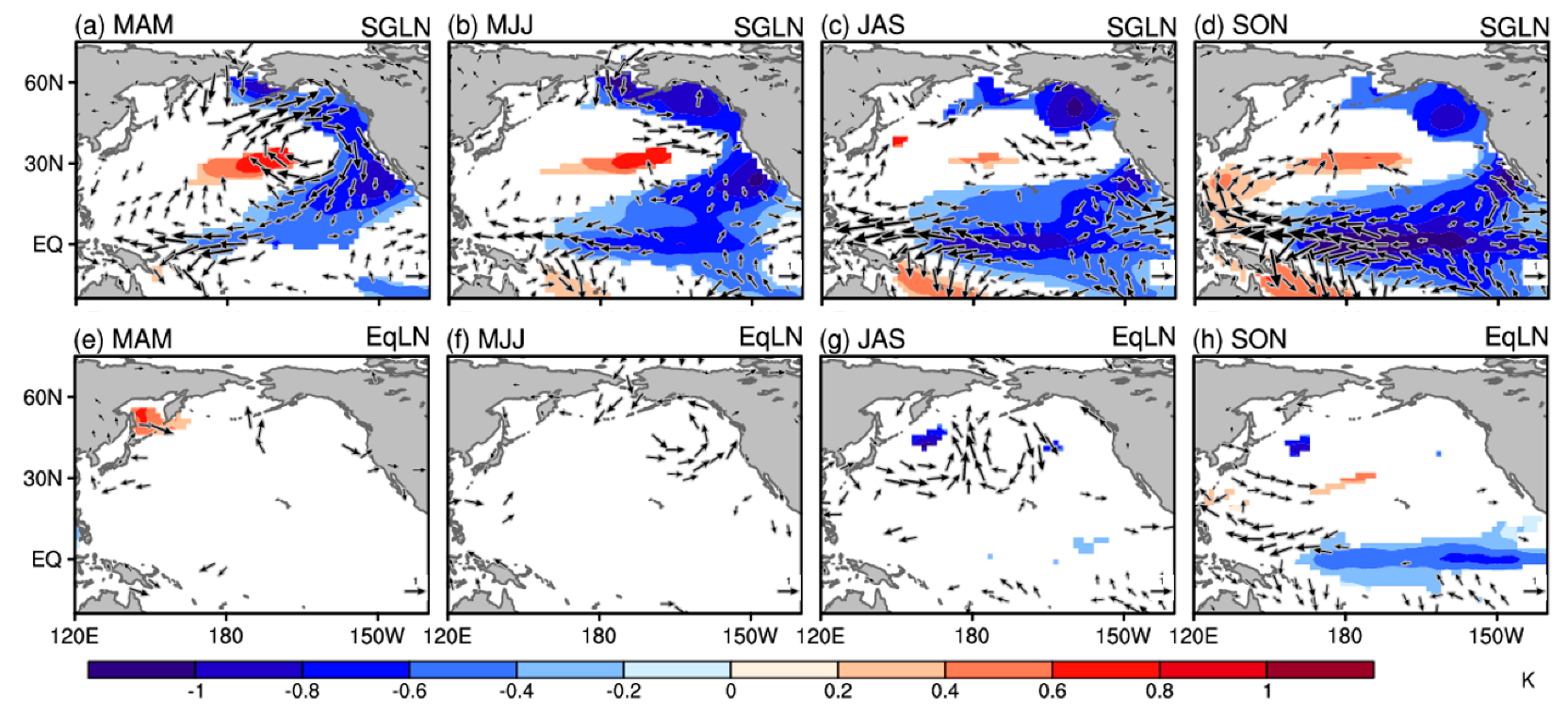
| Events | Years | Common Features |
|---|---|---|
| Strong El Niño | 1957–1958, 1965–1966, 1972–1973, 1982–1983, 1991–1992, 1997–1998, 2009–2010, 2015–2016 (8) | The strong warm (cool) SST anomalies in the eastern (western) Pacific with salient Indian Ocean warming |
| Strong La Niña | 1970–1971, 1973–1974, 1975–1976, 1988–1989, 1998–1999, 1999–2000, 2007–2008, 2010–2011 (8) | The strong cool (warm) SST anomalies in the eastern (western) Pacific |
| WSG-El Niño | 1958–1959, 1968–1969, 1976–1977, 1977–1978, 1979–1980, 1986–1987 (6) | The warm (cool) SST anomalies in the eastern (western) Pacific but amplitude weaker than strong El Nino |
| WSG-La Niña | 1971–1972, 1974–1975, 2000–2001, 2008–2009, 2011–2012 (5) | The same as WSG-El Nino but opposite in sign |
| Eq-El Niño | 1963–1964, 1969–1970, 1987–1988, 1994–1995, 2002–2003, 2004–2005, 2006–2007, 2014–2015 (8) | A significant zonal banded warming throughout the tropical oceans without a salient SST cooling in the western Pacific |
| Eq-La Niña | 1964–1965, 1967–1968, 1971–1972, 1983–1984, 1984–1985, 1985–1986, 1995–1996, 2005–2006 (8) | The same as Eq-El Nino but opposite in sign |
| Experiments | Description of SST Perturbation |
|---|---|
| SEN | SSTA associated with strong El Niño events is imposed in the Pacific (40° S–40° N, 120° E–90° W) |
| WSGEN | SSTA associated with strong gradient weak El Niño events is imposed in the tropical Pacific (40° S–40° N, 120° E–90° W) |
| EqEN | SSTA associated with weak gradient weak El Niño events is imposed in the tropical Pacific (15° S–15° N, 160° E–90° W) |
| IO | SSTA associated with strong El Niño events is imposed in the Indian Ocean (20° S–20° N, 40° E–110° E) |
| SEN_IO | SEN and IO SSTA forcings are added together |
| EqEN_IO | SSTA associated with weak gradient weak El Niño events is imposed in the tropical Pacific (20° S–20° N, 160° E–90° W) and Indian Ocean (20° S–20° N, 40° E–110° E) |
| SGLN | SSTA associated with strong gradient (strong and strong gradient weak) La Niña events is imposed in the tropical Pacific (40° S–40° N, 120° E–120° W) |
| WSGLN | SSTA associated with strong gradient weak La Niña events is imposed in the tropical Pacific (40° S–40° N, 120° E–120° W) |
| EqLN | SSTA associated with weak gradient weak La Niña events is imposed in the tropical Pacific (15° S–15° N, 150° E–90° W) |
Disclaimer/Publisher’s Note: The statements, opinions and data contained in all publications are solely those of the individual author(s) and contributor(s) and not of MDPI and/or the editor(s). MDPI and/or the editor(s) disclaim responsibility for any injury to people or property resulting from any ideas, methods, instructions or products referred to in the content. |
© 2023 by the authors. Licensee MDPI, Basel, Switzerland. This article is an open access article distributed under the terms and conditions of the Creative Commons Attribution (CC BY) license (https://creativecommons.org/licenses/by/4.0/).
Share and Cite
Zhang, P.; Wu, Z. Insight into Asymmetry in the Impact of Different Types of ENSO on the NAO. Climate 2023, 11, 136. https://doi.org/10.3390/cli11070136
Zhang P, Wu Z. Insight into Asymmetry in the Impact of Different Types of ENSO on the NAO. Climate. 2023; 11(7):136. https://doi.org/10.3390/cli11070136
Chicago/Turabian StyleZhang, Peng, and Zhiwei Wu. 2023. "Insight into Asymmetry in the Impact of Different Types of ENSO on the NAO" Climate 11, no. 7: 136. https://doi.org/10.3390/cli11070136
APA StyleZhang, P., & Wu, Z. (2023). Insight into Asymmetry in the Impact of Different Types of ENSO on the NAO. Climate, 11(7), 136. https://doi.org/10.3390/cli11070136







